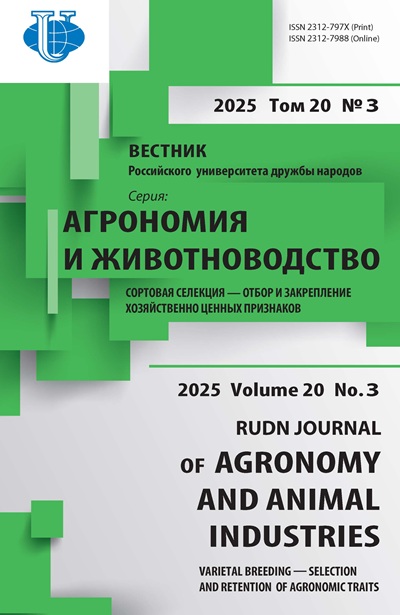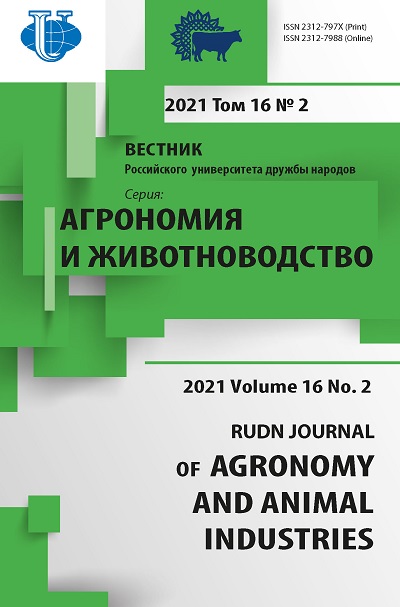Том 16, № 2 (2021)
- Год: 2021
- Статей: 7
- URL: https://agrojournal.rudn.ru/agronomy/issue/view/1116
- DOI: https://doi.org/10.22363/2312-797X-2021-16-2
Весь выпуск
Растениеводство
Фенологические особенности развития красноокрашенных сортов амаранта в условиях открытого грунта Московской области с высоким содержанием натурального пигмента амарантина
Аннотация
Показаны фенологические особенности реакции сортов в зависимости от изменчивости погодных условий в открытом грунте Московской области. Одним из перспективных соединений красноокрашенных форм амаранта является представитель группы беталаиновых пигментов - амарантин. Выявлены фазы с максимальным содержанием амарантина с одного растения и рассмотрена динамика накопления исследуемого пигмента суммарно в листьях и соцветиях растений амаранта в расчете на единицу площади. Фенологические наблюдения за интродуцированными видами растений в новых условиях имеют важное значение и определяют их устойчивость к неблагоприятным факторам среды, способность давать полноценные плоды и семена и возможность их ввода в культуру. При введении новых видов и сортов амаранта проводят отбор более приспособленных форм для условий Нечерноземной зоны РФ, в которые они попали. Рассмотренные в исследовании сорта растений амаранта относили к четырем различным группам по продолжительности периода вегетации в открытом грунте от всходов до созревания семян (2013-2016 гг.). Анализ фенологических особенностей развития амаранта сортов селекции ВНИИССОК и Эквадора выявил, что изменчивость продолжительности стадий развития амаранта не зависит от сортового фактора, за исключением четвертой стадии позднеспелых сортообразцов Дон Педро и Эку 17020, зависимой от погодных условий. При анализе генотипической изменчивости наиболее стабильным оказался вегетативный период развития в разные годы исследований, продолжительность которого зависит от погодных условий. Для позднеспелого образца Эку 17020 характерно увеличение стадии созревания, в результате которой в открытом грунте образец эквадорской селекции не формировал зрелых семян. В исследовании выявлены оптимальные фазы для получения натурального растительного сырья с максимальным выходом красителя из красноокрашенных сортов амаранта Валентина, Дон Педро и Факел. Рассмотрена перспектива выращивания зеленолистных сортов Памяти Коваса и Эку 17020 с красными соцветиями в качестве источников биологически ценных соединений в условиях Московской области.
 107-117
107-117


Оценка урожайности, пластичности и стабильности образцов ярового ячменя в условиях Европейского Севера РФ
Аннотация
Современные агроклиматические условия окружающей среды Европейского Севера РФ за последние годы определяются постоянными колебаниями биотических и абиотических факторов, что требует от сортов для сельскохозяйственного производства высокого уровня пластичности и стабильности урожайности и количественных признаков. Поэтому определение уровня реакции растений на изменчивые факторы среды с целью отбора наиболее перспективного селекционного материала является важной задачей селекционеров. Исследования проводились на опытном поле ФИЦКИА УрО РАН (г. Котлас). В питомнике конкурсного испытания изучались образцы ячменя ярового местной селекции. Показатели пластичности и стабильности сорта рассчитывали по методу С.А. Эберхарта, В.А. Рассела (1966), показатель генетической гибкости — по методу Р.А. Удачина (1990). Различные погодные условия за период исследований дали возможность разносторонне оценить селекционный материал. Гидротермический коэффициент по Г.Т. Селянинову (ГТК) за годы исследований варьировал от 1,85 до 3,06. Проведен анализ десяти образцов ячменя ярового за период 2017—2019 гг. на выявление пластичного, стабильного генотипа. В результате исследований высокий уровень стабильности показали образцы k-037712 (Ϭ2 = 0,01), k-038404 (Ϭ2 = 0,02). Выявлены образцы с нейтральным генотипом: k-039257, k-036982 (bi < 1) и образец слабо реагирующий на изменения условий среды к-038806 (bi = 0,23). Значение bi близко к 1 у сорта Котласский, что показывает высокую экологическую пластичность сорта. Образец k-038806 с наименьшим коэффициентом линейной регрессии — 0,23 подходит для выращивания на естественном агрофоне. Выделенные генетические источники будут использованы в селекционной работе для создания высокопродуктивных сортов ярового ячменя для условий Европейского Севера РФ.
 118-128
118-128


Изучение различий биологической эффективности применения одно- и двухкомпонентного граминицида на сахарной свекле в условиях Тульской области
Аннотация
Одна из наиболее актуальных проблем при возделывании сахарной свеклы в России — нарушение технологии выращивания и низкоэффективная защита данной культуры, что приводит к высокой засоренности полей. Разработка и подбор наиболее высокоэффективных, селективных и доступных гербицидов, которые обладают низкой фитотоксичностью и не ухудшают химических свойств почвы, для применения на посевах сахарной свеклы остается актуальной по сей день. Цель данного исследования — изучить биологическую эффективность применения различных доз одно- или двухкомпонентных граминицидов на посевах сахарной свеклы против таких сорных растений, как пырей ползучий (Elytrigia repens (L.) Nevski), куриное просо (Echinochloa crusgalli (L.) Beauv.), щетинник сизый (Setaria glauca (L.) Beauv). Исследование проводилось территории Тульской области в 2020 г. Общая площадь опыта составила 480 м2. Использование нормы расхода действующих веществ клетодим + хизалофоп-П-этил с нормой расхода 0,5 л/га снижало количество и массу однолетних злаковых сорняков на 64…71 %, количество и массу многолетних злаковых сорняков на 54…58 %, что было на уровне эффективности использования нормы расхода действующего вещества клетодим 0,6 л/га. Эффективность нормы расхода 1,0 л/га препаративной формы на основе клетодима + хизалофоп-П-этила была выше эффективности нормы расхода 0,6 л/га препаративной формы на основе клетодима, но ниже эффективности нормы расхода 1,8 л/га препаративной формы на основе клетодима. Наибольшую прибавку урожайности получили при использовании норм расхода 1,8 л/га препаративной формы на основе клетодима — 28 % и 1 л/га двухкомпонентного гербицида — 25 %.
 129-136
129-136


Защита растений
Филогенетический анализ и разработка новых праймеров для молекулярной идентификации Drosophila suzukii
Аннотация
Семейство Drosophilidae насчитывает более 3750 видов по всему миру, из них к роду Drosophila относится более 2000 видов, причем, Drosophila suzukii считается одним из самых опасных представителей этого семейства. Личинок вредителя крайне трудно или практически невозможно обнаружить, так как азиатская ягодная дрозофила большую часть жизненного цикла проводит внутри плода. Вылупляющиеся из яиц личинки Drosophila suzukii питаются здоровыми плодами, вызывая размягчение тканей и загнивание плодов. Эксперименты проводились на базе Всероссийского центра карантина растений и в Аграрно-технологическом институте Российского университета дружбы народов в 2018—2020 гг. Цель исследования — подобрать метод точной и быстрой диагностики вредителя, разработать специфические пары праймеров для ПЦР в реальном времени. На сегодняшний день количественная ПЦР — это быстрый, высокочувствительный, воспроизводимый и наиболее точный метод диагностики. По результатам исследования были разработаны специфические праймеры (4.Dsuz.FRP), позволяющие с высокой точностью отличать D. suzukii от других родственных видов при использовании метода ПЦР в реальном времени. Хотя появление D. suzukii не было зафиксировано на территории Российской Федерации, исследование дает возможность быстро и с высокой точностью идентифицировать вредителя в случае его возможного завоза, а также поможет предотвратить его последующее распространение.
 137-145
137-145


Агротехнологии и мелиорация земель
Модель мониторинга нефтяного загрязнения почвы и его прекращения
Аннотация
Оценка влияния хозяйственной деятельности нефтедобывающего комплекса России на загрязнение земель способствует принятию эволюционных управленческих решений. В нефтяном комплексе промышленное загрязнение отрицательно сказывается на флоре и фауне, поэтому необходимо определить уровень воздействия, степень его опасности, место заражения. Нужен системный подход. При изучении экологической среды важно учитывать наличие рисковых ситуаций и стохастических необратимых изменений. Идентификация характера и типа загрязнения почвы нефтепродуктами должна проводиться с использованием высокотехнологичного инструментария, интеллектуальных процедур. Рассмотрены моделирование ситуации загрязнения почв, прогнозирование и идентификация нефтяных загрязнений, также подмодель оптимального прекращения мониторинга. Прекращение наблюдений за оптимизацией окружающей среды приведет к снижению затрат на наблюдение, поскольку мониторинг загрязненной нефтепродуктами окружающей среды является дорогостоящим и сложным технологическим механизмом, часто требующим спутниковых данных. Предлагаемый алгоритм моделирования и системного анализа основан на ситуационном моделировании. Эволюционное моделирование позволяет адаптировать процедуру (методологию) прогнозирования и оценки к факторам риска окружающей среды. Это повышает точность (формализация и доказательность) и полноту выводов, оперативность анализа ситуации, что влияет на управляемость риска как для нефтяного комплекса, так и для отдельного предприятия отрасли. Результаты работы могут быть использованы для разработки программных средств, в частности экспертных и прогнозных систем. Ситуационные модели необходимы, когда нефтяные компании решают многокритериальные и многофакторные задачи принятия решений.
 146-153
146-153


Животноводство
Использование иммуноферментного анализа для определения гликопротеинов беременности с целью диагностики стельности дойных коров в полевых условиях Алжира
Аннотация
Изучена эффективность ранней диагностики беременности у крупного рогатого скота в полевых условиях в Алжире с помощью нового доступного набора для иммуноферментного анализа, основанного на определении гликопротеинов, связанных с беременностью. Исследованы 120 коров голштино-фризской породы смешанного возраста из разных молочных стад. Контроль беременности у 68 стельных коров осуществляли методом ультразвуковой диагностики на 35…40-й день после инсеминации и подтверждали трансректальным исследованием через 2-3 месяца после проведения искусственного осеменения. 52 нестельных коров содержали изолированно от самцов на протяжении всего эксперимента. Образцы крови отбирались из хвостовой артерии в пробирки с ЭДТА. Плазму получали центрифугированием и хранили при температуре -20 °C до начала проведения анализа. Концентрации гликопротеинов беременности (ГПБ) у стельных и нестельных коров определяли в плазме крови с помощью набора реагентов ИФА. Воспроизводимость результатов ГПБ-ИФА (внутри- и межсерийной сходимости) удовлетворительна (2,78 и 13,19 % соответственно). Точность (≥ 94,8 %) и повторяемость анализа были в основном приемлемыми. Не наблюдалось перекрестной реакции с разными гормонами, протестированными в разных разведениях. Диагностическая чувствительность ГПБ-ИФА тест-системы составила 100 % и наблюдалась отрицательная прогностическая значимость. При этом специфичность и прогностическая ценность положительного результата составили 91,93 и 71,15 % соответственно. Точность диагностики беременности с помощью ГПБ-ИФА составила 87,5 %. Таким образом, настоящее исследование явно показывает, что набор для ИФА можно использовать для измерения содержания ГПБ в сыворотке крови коров с целью определения стельности. Следовательно, данный альтернативный метод может быть рекомендован для замены методов иммуноанализа с применением радиоактивных изотопов для улучшения репродуктивных показателей коров и является эффективным инструментом для воспроизводства молочного крупного рогатого скота.
 154-166
154-166


Влияние физических характеристик зернового сырья на функциональную ценность кормов для птиц
Аннотация
Целью настоящего исследования является анализ зарубежной научной литературы, посвященный влиянию физических характеристик зернового сырья на функциональную ценность получаемых на его основе кормов для птиц. Рассмотрены роль размера частиц зернового корма и его формы в обеспечении оптимального развития и функционирования желудочно-кишечного тракта (ЖКТ) и повышения продуктивности птиц. Результаты исследований показали, что использование корма крупного помола не только сопровождается увеличением относительной массы желудка у бройлеров по сравнению с кормлением более мелкими частицами, но и усилением ферментативного расщепления корма в ЖКТ и улучшением усвояемости содержащихся в нем питательных веществ. Обнаружено, что с повышением уровня включения грубой кукурузы в рацион количество полезных бактерий Lactobacillus spp . и Bifidobacteria spp . в ЖКТ увеличивалось, а количество условно патогенных микроорганизмов уменьшалось. У птиц, получающих гранулированный корм, найдено недостаточное развитие желудка, что обусловлено, главным образом, отсутствием его механической стимуляции. Предполагается, что с целью улучшения функции желудка и здоровья птиц целесообразно ввести в их рацион источник пищевых волокон. Показано, что добавление от 2 до 3% нерастворимого источника клетчатки в обычные рационы молодых цыплят на основе высокобелковой соевой муки и кукурузы может улучшить развитие их пищеварительного тракта и ростовые показатели.
 167-175
167-175
















